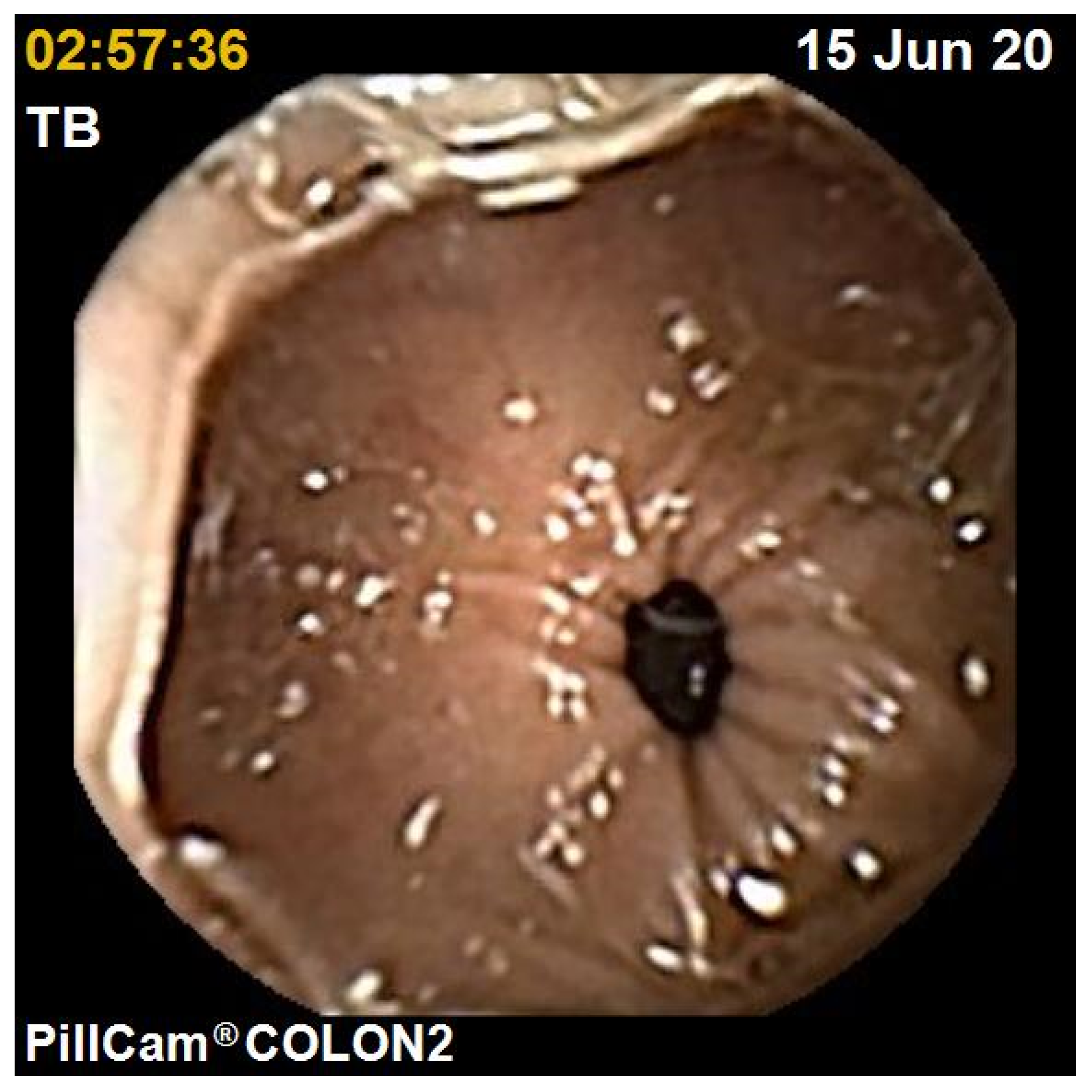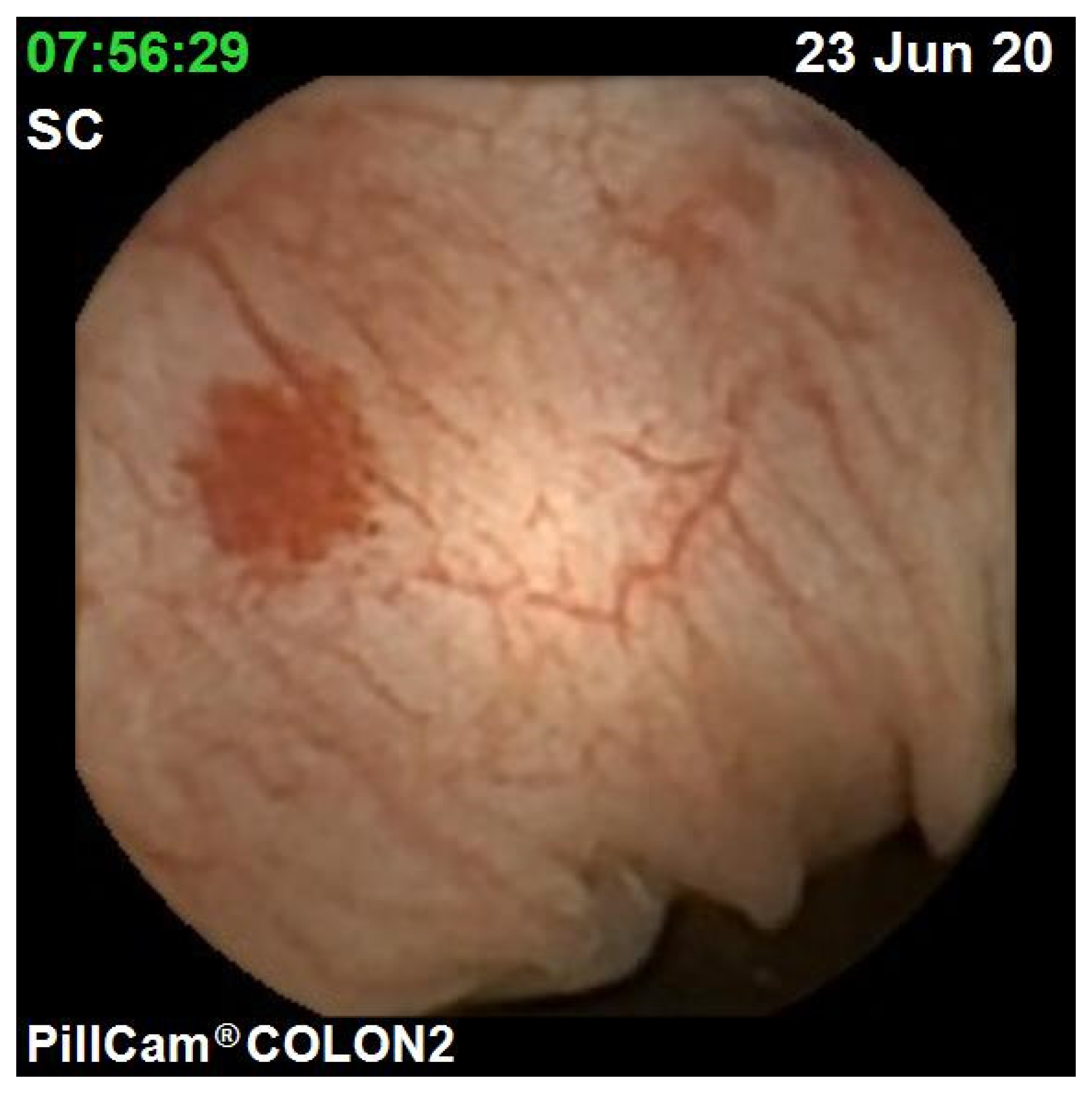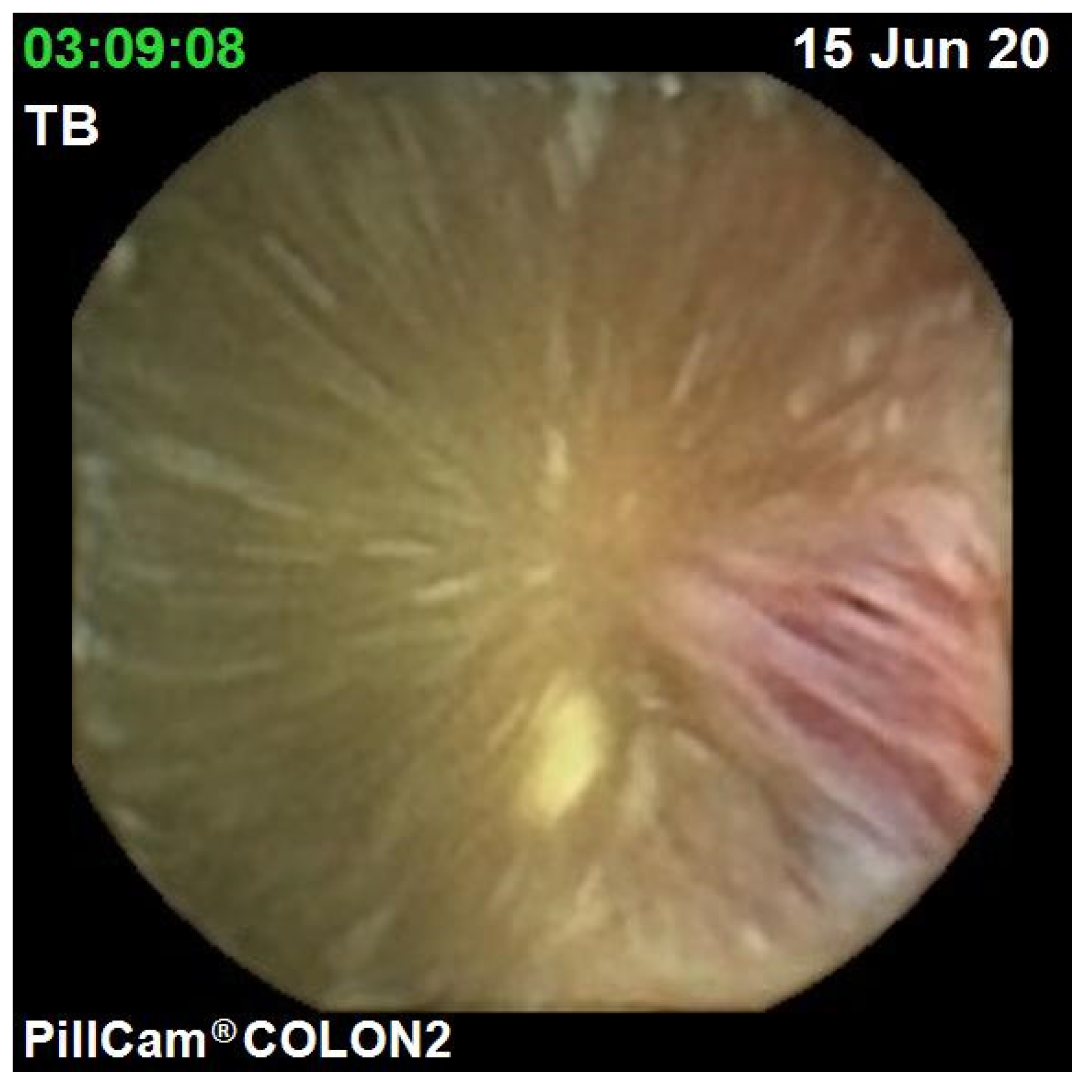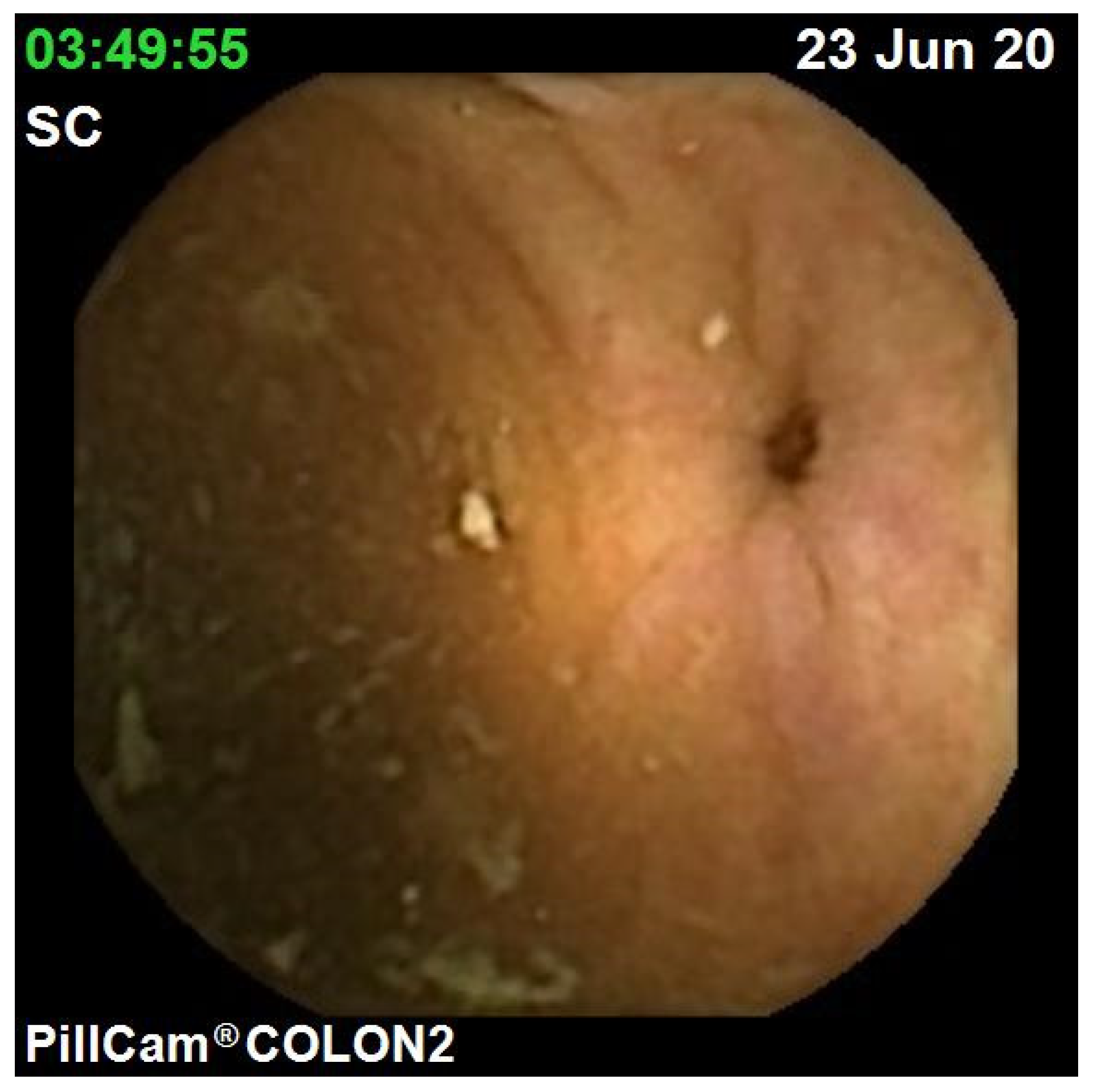Scoring Systems for Clinical Colon Capsule Endoscopy—All You Need to Know
Abstract
1. Introduction
2. Bowel Cleanliness Scoring
2.1. Colon Capsule Bowel Cleansing Scores
2.1.1. Operator-Dependent Scores
2.1.2. Computer-Dependent Scores
3. Mucosal Disease Activity in Inflammatory Bowel Disease
3.1. Ulcerative Colitis
3.2. Crohn’s Disease
4. Polyp Detection and Size Estimation
5. Discussion
6. Conclusions
Author Contributions
Funding
Institutional Review Board Statement
Informed Consent Statement
Conflicts of Interest
References
- Spada, C.; Hassan, C.; Bellini, D.; Burling, D.; Cappello, G.; Carretero, C.; Dekker, E.; Eliakim, R.; De Haan, M.; Kaminski, M.F.; et al. Imaging alternatives to colonoscopy: CT colonography and colon capsule. European Society of Gastrointestinal Endoscopy (ESGE) and European Society of Gastrointestinal and Abdominal Radiology (ESGAR) Guideline–Update 2020. Endoscopy 2020, 52, 1127–1141. [Google Scholar] [CrossRef] [PubMed]
- NHS England NHS Rolls out Capsule Cameras to Test for Cancer. Available online: https://www.england.nhs.uk/2021/03/nhs-rolls-out-capsule-cameras-to-test-for-cancer/ (accessed on 21 March 2021).
- Vuik, F.E.R.; Nieuwenburg, S.A.V.; Moen, S.; Spada, C.; Senore, C.; Hassan, C.; Pennazio, M.; Rondonotti, E.; Pecere, S.; Kuipers, E.J.; et al. Colon capsule endoscopy in colorectal cancer screening: A systematic review. Endoscopy 2021. [Google Scholar] [CrossRef]
- Kjølhede, T.; Ølholm, A.M.; Kaalby, L.; Kidholm, K.; Qvist, N.; Baatrup, G. Diagnostic accuracy of capsule endoscopy compared with colonoscopy for polyp detection: Systematic review and meta-analyses. Endoscopy 2020. [Google Scholar] [CrossRef] [PubMed]
- Deding, U.; Kaalby, L.; Bøggild, H.; Plantener, E.; Wollesen, M.K.; Kobaek-Larsen, M.; Hansen, S.J.; Baatrup, G. Colon Capsule Endoscopy vs. CT Colonography Following Incomplete Colonoscopy: A Systematic Review with Meta-Analysis. Cancers 2020, 12, 3367. [Google Scholar] [CrossRef]
- Limdi, J.K.; Picco, M.; Farraye, F.A. A review of endoscopic scoring systems and their importance in a treat-to-target approach in inflammatory bowel disease (with videos). Gastrointest. Endosc. 2020, 91, 733–745. [Google Scholar] [CrossRef]
- Calderwood, A.H.; Jacobson, B.C. Comprehensive validation of the Boston Bowel Preparation Scale. Gastrointest. Endosc. 2010, 72, 686–692. [Google Scholar] [CrossRef]
- Lai, E.J.; Calderwood, A.H.; Doros, G.; Fix, O.K.; Jacobson, B.C. The Boston bowel preparation scale: A valid and reliable instrument for colonoscopy-oriented research. Gastrointest. Endosc. 2009, 69, 620–625. [Google Scholar] [CrossRef]
- Van Gossum, A.; Munoz-Navas, M.; Fernandez-Urien, I.; Carretero, C.; Gay, G.; Delvaux, M.; Lapalus, M.G.; Ponchon, T.; Neuhaus, H.; Philipper, M.; et al. Capsule Endoscopy versus Colonoscopy for the Detection of Polyps and Cancer. N. Engl. J. Med. 2009, 361, 264–270. [Google Scholar] [CrossRef]
- Singhal, S.; Nigar, S.; Paleti, V.; Lane, D.; Duddempudi, S. Bowel preparation regimens for colon capsule endoscopy: A review. Ther. Adv. Gastroenterol. 2014, 7, 115–122. [Google Scholar] [CrossRef]
- Neri, E.; Halligan, S.; Hellström, M.; Lefere, P.; Mang, T.; Regge, D.; Stoker, J.; Taylor, S.; Laghi, A. The second ESGAR consensus statement on CT colonography. Eur. Radiol. 2013, 23, 720–729. [Google Scholar] [CrossRef]
- Ojidu, H.; Palmer, H.; Lewandowski, J.; Hampton, J.; Blakeborough, T.; Epstein, O.; McAlindon, M.E. Patient tolerance and acceptance of different colonic imaging modalities. Eur. J. Gastroenterol. Hepatol. 2018, 30, 520–525. [Google Scholar] [CrossRef]
- Woodbridge, L.; Wylie, P. Current Issues in Computed Tomography Colonography. Semin. Ultrasound CT MRI 2016, 37, 331–338. [Google Scholar] [CrossRef]
- Magalhães, R.D.S.; Arieira, C.; Carvalho, P.B.; Rosa, B.; Moreira, M.J.; Cotter, J. Colon Capsule CLEansing Assessment and Report (CC-CLEAR): A new approach for evaluation of the quality of bowel preparation in capsule colonoscopy. Gastrointest. Endosc. 2021, 93, 212–223. [Google Scholar] [CrossRef]
- Becq, A.; Histace, A.; Camus, M.; Nion-Larmurier, I.; Ali, E.A.; Pietri, O.; Romain, O.; Chaput, U.; Li, C.; Marteau, P.; et al. Development of a computed cleansing score to assess quality of bowel preparation in colon capsule endoscopy. Endosc. Int. Open 2018, 6, E844–E850. [Google Scholar] [CrossRef]
- Hosoe, N.; Hayashi, Y.; Ogata, H. Colon Capsule Endoscopy for Inflammatory Bowel Disease. Clin. Endosc. 2020, 53, 550–554. [Google Scholar] [CrossRef]
- Hosoe, N.; Nakano, M.; Takeuchi, K.; Endo, Y.; Matsuoka, K.; Abe, T.; Omori, T.; Hayashida, M.; Kobayashi, T.; Yoshida, A.; et al. Establishment of a Novel Scoring System for Colon Capsule Endoscopy to Assess the Severity of Ulcerative Colitis—Capsule Scoring of Ulcerative Colitis. Inflamm. Bowel Dis. 2018, 24, 2641–2647. [Google Scholar] [CrossRef]
- Travis, S.P.L.; Schnell, D.; Krzeski, P.; Abreu, M.T.; Altman, D.G.; Colombel, J.-F.; Feagan, B.G.; Hanauer, S.B.; Lémann, M.; Lichtenstein, G.R.; et al. Developing an instrument to assess the endoscopic severity of ulcerative colitis: The Ulcerative Colitis Endoscopic Index of Severity (UCEIS). Gut 2011, 61, 535–542. [Google Scholar] [CrossRef]
- Theede, K.; Holck, S.; Ibsen, P.; Ladelund, S.; Nordgaard-Lassen, I.; Nielsen, A.M. Level of Fecal Calprotectin Correlates With Endoscopic and Histologic Inflammation and Identifies Patients With Mucosal Healing in Ulcerative Colitis. Clin. Gastroenterol. Hepatol. 2015, 13, 1929–1936. [Google Scholar] [CrossRef]
- Matsubayashi, M.; Kobayashi, T.; Okabayashi, S.; Nakano, M.; Sagami, S.; Ozaki, R.; Kiyohara, H.; Morikubo, H.; Asonuma, K.; Miyatani, Y.; et al. Determining the usefulness of Capsule Scoring of Ulcerative Colitis in predicting relapse of inactive ulcerative colitis. J. Gastroenterol. Hepatol. 2021, 36, 943–950. [Google Scholar] [CrossRef]
- Niv, Y.; Gal, E.; Gabovitz, V.; Hershkovitz, M.; Lichtenstein, L.; Avni, I. Capsule Endoscopy Crohn’s Disease Activity Index (CECDAIic or Niv Score) for the Small Bowel and Colon. J. Clin. Gastroenterol. 2018, 52, 45–49. [Google Scholar] [CrossRef]
- Arieira, C.; Magalhães, R.; De Castro, F.D.; Carvalho, P.B.; Rosa, B.; Moreira, M.J.; Cotter, J. CECDAIic—A new useful tool in pan-intestinal evaluation of Crohn’s disease patients in the era of mucosal healing. Scand. J. Gastroenterol. 2019, 54, 1326–1330. [Google Scholar] [CrossRef] [PubMed]
- Parodi, A.; Vanbiervliet, G.; Hassan, C.; Hebuterne, X.; De Ceglie, A.; Filiberti, R.A.; Spada, C.; Conio, M. Colon capsule endoscopy to screen for colorectal neoplasia in those with family histories of colorectal cancer. Gastrointest. Endosc. 2018, 87, 695–704. [Google Scholar] [CrossRef] [PubMed]
- Hall, B.; Holleran, G.; McNamara, D. PillCam COLON 2© as a pan-enteroscopic test in Crohn’s disease. World J. Gastrointest. Endosc. 2015, 7, 1230–1232. [Google Scholar] [CrossRef] [PubMed]
- Saunders, R.; Torres, R.T.; Konsinski, L.; Kosinski, L. Evaluating the clinical and economic consequences of using video capsule endoscopy to monitor Crohn’s disease. Clin. Exp. Gastroenterol. 2019, 12, 375–384. [Google Scholar] [CrossRef]
- Ontario, H.Q. Colon capsule endoscopy for the detection of colorectal polyps: An evidence-based analysis. Ont. Health Technol. Assess. Ser. 2015, 15, 1–39. Available online: http://www.hqontario.ca/evidence/evidence-process/evidence-review-process/professional-and-public (accessed on 16 March 2021).
- Hussey, M.; Holleran, G.; Stack, R.; Moran, N.; Tersaruolo, C.; McNamara, D. Same-day colon capsule endoscopy is a viable means to assess unexplored colonic segments after incomplete colonoscopy in selected patients. United Eur. Gastroenterol. J. 2018, 6, 1556–1562. [Google Scholar] [CrossRef]
- Baltes, P.; Bota, M.; Albert, J.; Philipper, M.; Hörster, H.-G.; Hagenmüller, F.; Steinbrück, I.; Jakobs, R.; Bechtler, M.; Hartmann, D.; et al. PillCamColon2 after incomplete colonoscopy—A prospective multicenter study. World J. Gastroenterol. 2018, 24, 3556–3566. [Google Scholar] [CrossRef]
- Nogales, Ó.; García-Lledó, J.; Luján, M.; Nicolás, D.; Juanmartiñena, J.F.; González-Suárez, B.; Ceballos, F.S.; Couto, I.; Olmedo, J.; Garfia, C.; et al. Therapeutic impact of colon capsule endoscopy with PillCam? COLON 2 after incomplete standard colonoscopy: A Spanish multicenter study. Rev. Española Enferm. Dig. 2017, 109, 322–327. [Google Scholar] [CrossRef][Green Version]
- Triantafyllou, K.; Viazis, N.; Tsibouris, P.; Zacharakis, G.; Kalantzis, C.; Karamanolis, D.G.; Ladas, S.D. Colon capsule endoscopy is feasible to perform after incomplete colonoscopy and guides further workup in clinical practice. Gastrointest. Endosc. 2014, 79, 307–316. [Google Scholar] [CrossRef]
- Alarcón–Fernández, O.; Ramos, L.; Adrián–De–Ganzo, Z.; Gimeno–García, A.Z.; Nicolás–Pérez, D.; Jiménez, A.; Quintero, E. Effects of Colon Capsule Endoscopy on Medical Decision Making in Patients With Incomplete Colonoscopies. Clin. Gastroenterol. Hepatol. 2013, 11, 534–540. [Google Scholar] [CrossRef]
- Spada, C.; Pasha, S.F.; Gross, S.A.; Leighton, J.A.; Schnoll-Sussman, F.; Correale, L.; Suárez, B.G.; Costamagna, G.; Hassan, C. Accuracy of First-and Second-Generation Colon Capsules in Endoscopic Detection of Colorectal Polyps: A Systematic Review and Meta-analysis. Clin. Gastroenterol. Hepatol. 2016, 14, 1533–1543. [Google Scholar] [CrossRef]
- Hagel, A.F.; Gäbele, E.; Raithel, M.; Hagel, W.H.; Albrecht, H.; de Rossi, T.M.; Singer, C.; Schneider, T.; Neurath, M.F.; Farnbacher, M.J. Colon Capsule Endoscopy: Detection of Colonic Polyps Compared with Conventional Colonoscopy and Visualization of Extracolonic Pathologies. Can. J. Gastroenterol. Hepatol. 2014, 28, 77–82. [Google Scholar] [CrossRef]
- Nakazawa, K.; Nouda, S.; Kakimoto, K.; Kinoshita, N.; Tanaka, Y.; Tawa, H.; Koshiba, R.; Naka, Y.; Hirata, Y.; Ota, K.; et al. The Differential Diagnosis of Colorectal Polyps Using Colon Capsule Endoscopy. Intern. Med. 2021, 6446-20. [Google Scholar] [CrossRef]
- Rondonotti, E.; Borghi, C.; Mandelli, G.; Radaelli, F.; Paggi, S.; Amato, A.; Imperiali, G.; Terreni, N.; Lenoci, N.; Terruzzi, V.; et al. Accuracy of Capsule Colonoscopy and Computed Tomographic Colonography in Individuals With Positive Results From the Fecal Occult Blood Test. Clin. Gastroenterol. Hepatol. 2014, 12, 1303–1310. [Google Scholar] [CrossRef]
- Cash, B.D.; Fleisher, M.R.; Fern, S.; Rajan, E.; Haithcock, R.; Kastenberg, D.M.; Pound, D.; Papageorgiou, N.P.; Fernández-Urién, I.; Schmelkin, I.J.; et al. Multicentre, prospective, randomised study comparing the diagnostic yield of colon capsule endoscopy versus CT colonography in a screening population (the TOPAZ study). Gut 2020. [Google Scholar] [CrossRef]
- Dockter, A.G.; Angelos, G.C. Stool-based DNA testing versus colon capsule endoscopy for colorectal cancer screening during the COVID-19 pandemic: A response to ‘Colon capsule endoscopy: An innovative method for detecting colorectal pathology during the COVID-19 pandemic ? Color. Dis. 2020, 22, 1027–1028. [Google Scholar] [CrossRef]
- Pasha, S.F. Applications of Colon Capsule Endoscopy. Curr. Gastroenterol. Rep. 2018, 20, 22. [Google Scholar] [CrossRef]
- Spada, C.; Hassan, C.; Galmiche, J.-P.; Neuhaus, H.; Dumonceau, J.-M.; Adler, S.N.; Epstein, O.; Gay, G.; Pennazio, M.; Rex, D.K.; et al. Colon capsule endoscopy: European Society of Gastrointestinal Endoscopy (ESGE) Guideline. Endoscopy 2012, 44, 527–536. [Google Scholar] [CrossRef]
- Villa, N.A.; Pannala, R.; Pasha, S.F.; Leighton, J.A. Alternatives to Incomplete Colonoscopy. Curr. Gastroenterol. Rep. 2015, 17. [Google Scholar] [CrossRef]
- Spada, C.; Hassan, C.; Barbaro, B.; Iafrate, F.; Cesaro, P.; Petruzziello, L.; Grazioli, L.M.; Senore, C.; Brizi, M.G.; Costamagna, I.; et al. Colon capsule versus CT colonography in patients with incomplete colonoscopy: A prospective, comparative trial. Gut 2014, 64, 272–281. [Google Scholar] [CrossRef]
- Milluzzo, S.M.; Bizzotto, A.; Cesaro, P.; Spada, C. Colon capsule endoscopy and its effectiveness in the diagnosis and management of colorectal neoplastic lesions. Expert Rev. Anticancer. Ther. 2018, 19, 71–80. [Google Scholar] [CrossRef] [PubMed]
- Negreanu, L.; Babiuc, R.; Bengus, A.; Sadagurschi, R. PillCam Colon 2 capsule in patients unable or unwilling to undergo colonoscopy. World J. Gastrointest. Endosc. 2013, 5, 559–567. [Google Scholar] [CrossRef] [PubMed]
- Hassan, C.; Zullo, A.; Winn, S.; Morini, S. Cost-effectiveness of capsule endoscopy in screening for colorectal cancer. Endoscopy 2008, 40, 414–421. [Google Scholar] [CrossRef] [PubMed]
- Yee, J.; McFarland, E. Extracolonic findings and radiation at CT colonography: What the referring provider needs to know. Abdom. Radiol. 2018, 43, 554–565. [Google Scholar] [CrossRef]
- Muguruma, N.; Tanaka, K.; Teramae, S.; Takayama, T. Colon capsule endoscopy: Toward the future. Clin. J. Gastroenterol. 2017, 10, 1–6. [Google Scholar] [CrossRef]
- Wang, Y.-C.; Pan, J.; Liu, Y.-W.; Sun, F.-Y.; Qian, Y.-Y.; Jiang, X.; Zou, W.-B.; Xia, J.; Jiang, B.; Ru, N.; et al. Adverse events of video capsule endoscopy over the past two decades: A systematic review and proportion meta-analysis. BMC Gastroenterol. 2020, 20, 1–11. [Google Scholar] [CrossRef]
- Koulaouzidis, A.; Dabos, K.; Philipper, M.; Toth, E.; Keuchel, M. How should we do colon capsule endoscopy reading: A practical guide. Ther. Adv. Gastrointest. Endosc. 2021, 14, 263177452110019. [Google Scholar] [CrossRef]




| Grade | Colon Cleanliness |
|---|---|
| A | Large amount of faecal residue |
| B | Enough faeces or dark fluid present to preclude a completely reliable examination |
| C | Small amount of faeces or dark fluid, but not enough to interfere with examination |
| D | No more than small bits of adherent faeces |
| Rating | Description |
|---|---|
| Cleansing Level Scale | |
| Poor | Inadequate. Large amount of faecal residue precludes a complete examination |
| Fair | Inadequate but examination completed. Enough faeces or turbid fluid to prevent a reliable examination |
| Good | Adequate. Small amount of faeces or turbid fluid not interfering with examination |
| Excellent | Adequate. No more than small bits of adherent faeces |
| Bubbles Effect Scale | |
| Significant | Bubbles that interfere with the examination. More than 10% of surface area obscured by bubbles |
| Insignificant | No bubbles or bubbles that do not interfere with the examination. Less than 10% of surface area obscured by bubbles |
| Descriptor | Likert Scale Anchor Points | Definition |
|---|---|---|
| Vascular Pattern | Normal (0) | Normal vascular pattern |
| Patchy obliteration (1) | Obliterated area ≤ 30% | |
| Obliterated (2) | Obliterated area > 30% | |
| Bleeding | None (0) | No visible blood detected by image reading software |
| Mild (1) | No bleeding picture detected by image reading software ≤ 10 | |
| Severe (2) | No bleeding picture detected by image reading software > 10 | |
| Erosions and ulcers | None (0) | Normal mucosa, no visible erosions or ulcers |
| Erosions (1) | Tiny (≤5 mm) defects in the mucosa | |
| Superficial ulcer (2) | Larger (>5 mm) defects in the mucosa | |
| Deep ulcer (3) | Larger (>5 mm) and deeper excavated defects in the mucosa, with a slightly raised edge |
| Parameter | |
|---|---|
| A | Inflammation score |
| 0 | None |
| 1 | Mild to moderate oedema/hyperaemia/denudation |
| 2 | Severe oedema/hyperaemia/denudation |
| 3 | Bleeding, exudate, aphthous ulcer, erosion and small ulcers (<0.5 cm) |
| 4 | Moderate ulcer (0.5–2 cm), pseudopolyp |
| 5 | Large ulcer (>2 cm) |
| B | Extent of disease score |
| 0 | None |
| 1 | Focal disease (single segment) |
| 2 | Patchy disease (multiple segments) |
| 3 | Diffuse disease |
| C | Narrowing (stricture) |
| 0 | None |
| 1 | Single passed |
| 2 | Multiple passed |
| 3 | Obstruction |
| CCE | Diagnostic OC | CTC | |
|---|---|---|---|
| Bowel preparation | PEG + booster + prokinetic | PEG | Laxative-free regimens using faecal tagging solution [11] |
| Ionising radiation exposure | None | None | ≤3–6 mSv [45] |
| Need for sedation | None | Yes | None |
| Suitability in high-risk patients | Potentially unsuitable given relative aggressiveness of bowel preparation | Potentially unsuitable given sedation-related risks | Suitable owing to better tolerated bowel preparation and no need for sedation |
| Bowel insufflation | None | Yes | Yes |
| Extra-colonic findings | None | None | Yes |
| Detection of polyps ≥ 6 mm (sensitivity, specificity, respectively) | 88.2%, 87.8% [35] | ‘Gold standard’ | 88.2%, 87.8% [35] |
| Average cost | USD 950 [46] | USD 877 [44] | USD 500 [42] |
| Type of Computation | Name of Score | Quantitative vs. Qualitative | Colonic Segmental Division | Interobserver Agreement |
|---|---|---|---|---|
| Operator-Dependant | Leighton–Rex | Qualitative | 5 segments: caecum, right colon, transverse, left colon, and rectum | Kendall’s coefficient: 0.806 [14] |
| CC-Clear | Quantitative | 3 segments: right colon, transverse, and left colon | Kendall’s coefficient: 0.911 [14] | |
| Computer-Dependant | CAC | Qualitative | Pancolonic | Pearson’s: 0.53 [15] |
| Type of IBD | Name of Score | Quantitative vs. Qualitative | Parameters of Intestinal Pathology Used | Bowel Segmental Division | Scoring Formula | Interobserver Agreement |
|---|---|---|---|---|---|---|
| UC | CSUC | Quantitative | Uses UCEIS descriptors: Vascular pattern; Bleeding; Erosions and ulcer. | Proximal colon; Distal colon (divided at the splenic flexure) | Vascular pattern sum (proximal + distal) + bleeding sum + erosions and ulcers sum | Mean-weighted kappa value: 0.52 (95% CI 0.45–0.59) [17] |
| CD | CECDAIic | Quantitative | Inflammation (A); Extent of disease (B); Presence of strictures (C) | Proximal small bowel (1); Distal small bowel (2); Right colon (3); Left colon (4) | Total score = (A1 × B1 + C1) + (A2 × B2 + C2) + (A3 × B3 + C3) + (A4 × B4 + C4) | Kendall coefficient: 0.77 [21] |
Publisher’s Note: MDPI stays neutral with regard to jurisdictional claims in published maps and institutional affiliations. |
© 2021 by the authors. Licensee MDPI, Basel, Switzerland. This article is an open access article distributed under the terms and conditions of the Creative Commons Attribution (CC BY) license (https://creativecommons.org/licenses/by/4.0/).
Share and Cite
Tabone, T.; Koulaouzidis, A.; Ellul, P. Scoring Systems for Clinical Colon Capsule Endoscopy—All You Need to Know. J. Clin. Med. 2021, 10, 2372. https://doi.org/10.3390/jcm10112372
Tabone T, Koulaouzidis A, Ellul P. Scoring Systems for Clinical Colon Capsule Endoscopy—All You Need to Know. Journal of Clinical Medicine. 2021; 10(11):2372. https://doi.org/10.3390/jcm10112372
Chicago/Turabian StyleTabone, Trevor, Anastasios Koulaouzidis, and Pierre Ellul. 2021. "Scoring Systems for Clinical Colon Capsule Endoscopy—All You Need to Know" Journal of Clinical Medicine 10, no. 11: 2372. https://doi.org/10.3390/jcm10112372
APA StyleTabone, T., Koulaouzidis, A., & Ellul, P. (2021). Scoring Systems for Clinical Colon Capsule Endoscopy—All You Need to Know. Journal of Clinical Medicine, 10(11), 2372. https://doi.org/10.3390/jcm10112372







